Siyi Chen
International Institute for Urban Systems Engineering, Southeast University, Nanjing, China
Understanding Generalization in Diffusion Models via Probability Flow Distance
May 26, 2025Abstract:Diffusion models have emerged as a powerful class of generative models, capable of producing high-quality samples that generalize beyond the training data. However, evaluating this generalization remains challenging: theoretical metrics are often impractical for high-dimensional data, while no practical metrics rigorously measure generalization. In this work, we bridge this gap by introducing probability flow distance ($\texttt{PFD}$), a theoretically grounded and computationally efficient metric to measure distributional generalization. Specifically, $\texttt{PFD}$ quantifies the distance between distributions by comparing their noise-to-data mappings induced by the probability flow ODE. Moreover, by using $\texttt{PFD}$ under a teacher-student evaluation protocol, we empirically uncover several key generalization behaviors in diffusion models, including: (1) scaling behavior from memorization to generalization, (2) early learning and double descent training dynamics, and (3) bias-variance decomposition. Beyond these insights, our work lays a foundation for future empirical and theoretical studies on generalization in diffusion models.
The Dual Power of Interpretable Token Embeddings: Jailbreaking Attacks and Defenses for Diffusion Model Unlearning
Apr 30, 2025Abstract:Despite the remarkable generalization capabilities of diffusion models, recent studies have shown that these models can memorize and generate harmful content when prompted with specific text instructions. Although fine-tuning approaches have been developed to mitigate this issue by unlearning harmful concepts, these methods can be easily circumvented through jailbreaking attacks. This indicates that the harmful concept has not been fully erased from the model. However, existing attack methods, while effective, lack interpretability regarding why unlearned models still retain the concept, thereby hindering the development of defense strategies. In this work, we address these limitations by proposing an attack method that learns an orthogonal set of interpretable attack token embeddings. The attack token embeddings can be decomposed into human-interpretable textual elements, revealing that unlearned models still retain the target concept through implicit textual components. Furthermore, these attack token embeddings are robust and transferable across text prompts, initial noises, and unlearned models. Finally, leveraging this diverse set of embeddings, we design a defense method applicable to both our proposed attack and existing attack methods. Experimental results demonstrate the effectiveness of both our attack and defense strategies.
Understanding Representation Dynamics of Diffusion Models via Low-Dimensional Modeling
Feb 09, 2025



Abstract:This work addresses the critical question of why and when diffusion models, despite being designed for generative tasks, can excel at learning high-quality representations in a self-supervised manner. To address this, we develop a mathematical framework based on a low-dimensional data model and posterior estimation, revealing a fundamental trade-off between generation and representation quality near the final stage of image generation. Our analysis explains the unimodal representation dynamics across noise scales, mainly driven by the interplay between data denoising and class specification. Building on these insights, we propose an ensemble method that aggregates features across noise levels, significantly improving both clean performance and robustness under label noise. Extensive experiments on both synthetic and real-world datasets validate our findings.
Explaining and Mitigating the Modality Gap in Contrastive Multimodal Learning
Dec 10, 2024



Abstract:Multimodal learning has recently gained significant popularity, demonstrating impressive performance across various zero-shot classification tasks and a range of perceptive and generative applications. Models such as Contrastive Language-Image Pretraining (CLIP) are designed to bridge different modalities, such as images and text, by learning a shared representation space through contrastive learning. Despite their success, the working mechanisms underlying multimodal learning are not yet well understood. Notably, these models often exhibit a modality gap, where different modalities occupy distinct regions within the shared representation space. In this work, we conduct an in-depth analysis of the emergence of modality gap by characterizing the gradient flow learning dynamics. Specifically, we identify the critical roles of mismatched data pairs and a learnable temperature parameter in causing and perpetuating the modality gap during training. Furthermore, our theoretical insights are validated through experiments on practical CLIP models. These findings provide principled guidance for mitigating the modality gap, including strategies such as appropriate temperature scheduling and modality swapping. Additionally, we demonstrate that closing the modality gap leads to improved performance on tasks such as image-text retrieval.
Learning Diffusion Model from Noisy Measurement using Principled Expectation-Maximization Method
Oct 15, 2024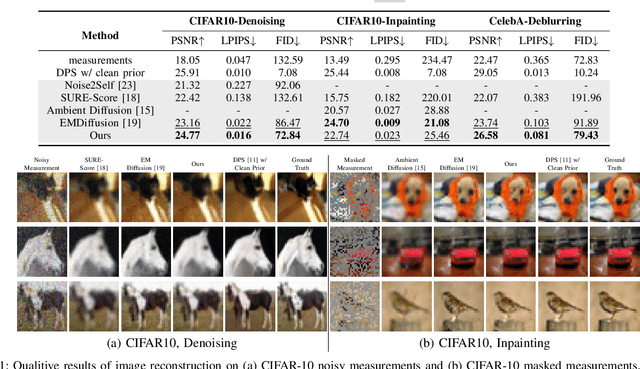
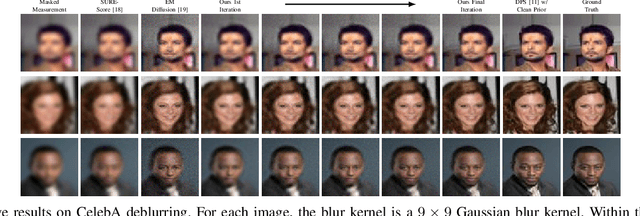
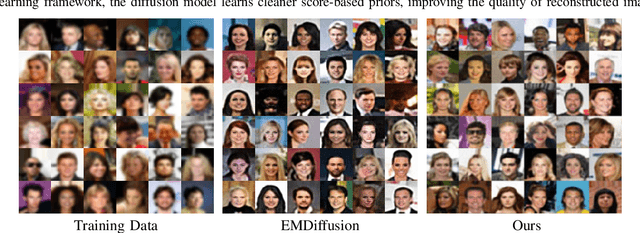
Abstract:Diffusion models have demonstrated exceptional ability in modeling complex image distributions, making them versatile plug-and-play priors for solving imaging inverse problems. However, their reliance on large-scale clean datasets for training limits their applicability in scenarios where acquiring clean data is costly or impractical. Recent approaches have attempted to learn diffusion models directly from corrupted measurements, but these methods either lack theoretical convergence guarantees or are restricted to specific types of data corruption. In this paper, we propose a principled expectation-maximization (EM) framework that iteratively learns diffusion models from noisy data with arbitrary corruption types. Our framework employs a plug-and-play Monte Carlo method to accurately estimate clean images from noisy measurements, followed by training the diffusion model using the reconstructed images. This process alternates between estimation and training until convergence. We evaluate the performance of our method across various imaging tasks, including inpainting, denoising, and deblurring. Experimental results demonstrate that our approach enables the learning of high-fidelity diffusion priors from noisy data, significantly enhancing reconstruction quality in imaging inverse problems.
Unfolding Videos Dynamics via Taylor Expansion
Sep 04, 2024



Abstract:Taking inspiration from physical motion, we present a new self-supervised dynamics learning strategy for videos: Video Time-Differentiation for Instance Discrimination (ViDiDi). ViDiDi is a simple and data-efficient strategy, readily applicable to existing self-supervised video representation learning frameworks based on instance discrimination. At its core, ViDiDi observes different aspects of a video through various orders of temporal derivatives of its frame sequence. These derivatives, along with the original frames, support the Taylor series expansion of the underlying continuous dynamics at discrete times, where higher-order derivatives emphasize higher-order motion features. ViDiDi learns a single neural network that encodes a video and its temporal derivatives into consistent embeddings following a balanced alternating learning algorithm. By learning consistent representations for original frames and derivatives, the encoder is steered to emphasize motion features over static backgrounds and uncover the hidden dynamics in original frames. Hence, video representations are better separated by dynamic features. We integrate ViDiDi into existing instance discrimination frameworks (VICReg, BYOL, and SimCLR) for pretraining on UCF101 or Kinetics and test on standard benchmarks including video retrieval, action recognition, and action detection. The performances are enhanced by a significant margin without the need for large models or extensive datasets.
Diffusion Models Learn Low-Dimensional Distributions via Subspace Clustering
Sep 04, 2024



Abstract:Recent empirical studies have demonstrated that diffusion models can effectively learn the image distribution and generate new samples. Remarkably, these models can achieve this even with a small number of training samples despite a large image dimension, circumventing the curse of dimensionality. In this work, we provide theoretical insights into this phenomenon by leveraging key empirical observations: (i) the low intrinsic dimensionality of image data, (ii) a union of manifold structure of image data, and (iii) the low-rank property of the denoising autoencoder in trained diffusion models. These observations motivate us to assume the underlying data distribution of image data as a mixture of low-rank Gaussians and to parameterize the denoising autoencoder as a low-rank model according to the score function of the assumed distribution. With these setups, we rigorously show that optimizing the training loss of diffusion models is equivalent to solving the canonical subspace clustering problem over the training samples. Based on this equivalence, we further show that the minimal number of samples required to learn the underlying distribution scales linearly with the intrinsic dimensions under the above data and model assumptions. This insight sheds light on why diffusion models can break the curse of dimensionality and exhibit the phase transition in learning distributions. Moreover, we empirically establish a correspondence between the subspaces and the semantic representations of image data, facilitating image editing. We validate these results with corroborated experimental results on both simulated distributions and image datasets.
Exploring Low-Dimensional Subspaces in Diffusion Models for Controllable Image Editing
Sep 04, 2024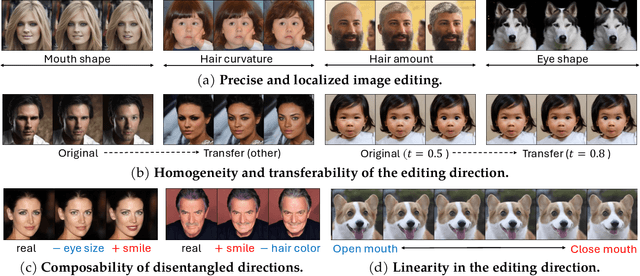
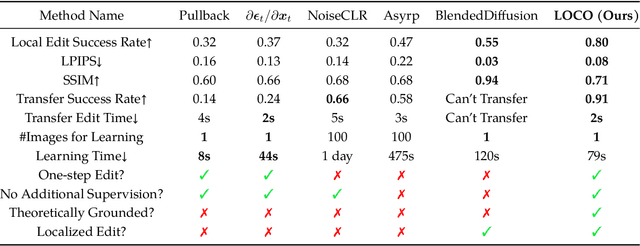
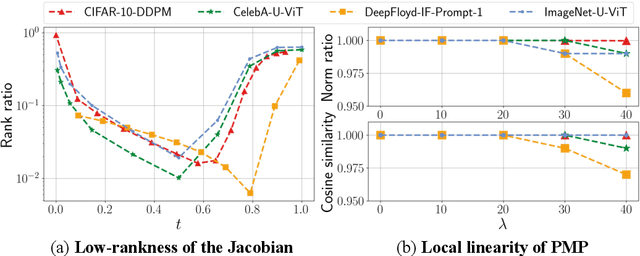

Abstract:Recently, diffusion models have emerged as a powerful class of generative models. Despite their success, there is still limited understanding of their semantic spaces. This makes it challenging to achieve precise and disentangled image generation without additional training, especially in an unsupervised way. In this work, we improve the understanding of their semantic spaces from intriguing observations: among a certain range of noise levels, (1) the learned posterior mean predictor (PMP) in the diffusion model is locally linear, and (2) the singular vectors of its Jacobian lie in low-dimensional semantic subspaces. We provide a solid theoretical basis to justify the linearity and low-rankness in the PMP. These insights allow us to propose an unsupervised, single-step, training-free LOw-rank COntrollable image editing (LOCO Edit) method for precise local editing in diffusion models. LOCO Edit identified editing directions with nice properties: homogeneity, transferability, composability, and linearity. These properties of LOCO Edit benefit greatly from the low-dimensional semantic subspace. Our method can further be extended to unsupervised or text-supervised editing in various text-to-image diffusion models (T-LOCO Edit). Finally, extensive empirical experiments demonstrate the effectiveness and efficiency of LOCO Edit. The codes will be released at https://github.com/ChicyChen/LOCO-Edit.
Blind Inversion using Latent Diffusion Priors
Jul 01, 2024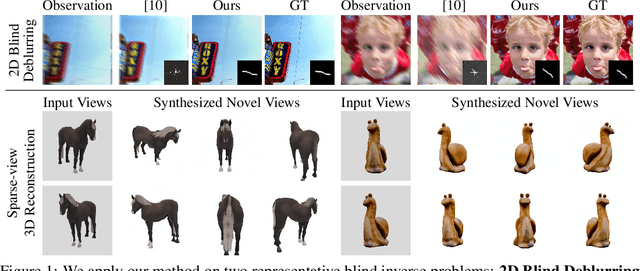

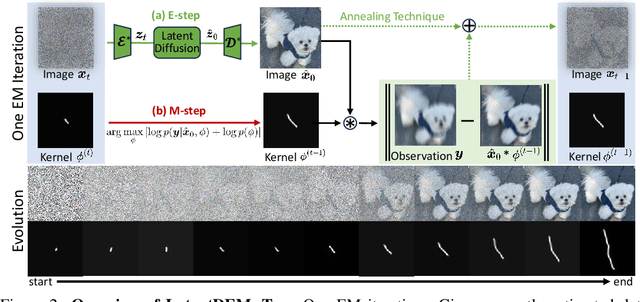

Abstract:Diffusion models have emerged as powerful tools for solving inverse problems due to their exceptional ability to model complex prior distributions. However, existing methods predominantly assume known forward operators (i.e., non-blind), limiting their applicability in practical settings where acquiring such operators is costly. Additionally, many current approaches rely on pixel-space diffusion models, leaving the potential of more powerful latent diffusion models (LDMs) underexplored. In this paper, we introduce LatentDEM, an innovative technique that addresses more challenging blind inverse problems using latent diffusion priors. At the core of our method is solving blind inverse problems within an iterative Expectation-Maximization (EM) framework: (1) the E-step recovers clean images from corrupted observations using LDM priors and a known forward model, and (2) the M-step estimates the forward operator based on the recovered images. Additionally, we propose two novel optimization techniques tailored for LDM priors and EM frameworks, yielding more accurate and efficient blind inversion results. As a general framework, LatentDEM supports both linear and non-linear inverse problems. Beyond common 2D image restoration tasks, it enables new capabilities in non-linear 3D inverse rendering problems. We validate LatentDEM's performance on representative 2D blind deblurring and 3D sparse-view reconstruction tasks, demonstrating its superior efficacy over prior arts.
Robust semi-automatic vessel tracing in the human retinal image by an instance segmentation neural network
Feb 15, 2024Abstract:The morphology and hierarchy of the vascular systems are essential for perfusion in supporting metabolism. In human retina, one of the most energy-demanding organs, retinal circulation nourishes the entire inner retina by an intricate vasculature emerging and remerging at the optic nerve head (ONH). Thus, tracing the vascular branching from ONH through the vascular tree can illustrate vascular hierarchy and allow detailed morphological quantification, and yet remains a challenging task. Here, we presented a novel approach for a robust semi-automatic vessel tracing algorithm on human fundus images by an instance segmentation neural network (InSegNN). Distinct from semantic segmentation, InSegNN separates and labels different vascular trees individually and therefore enable tracing each tree throughout its branching. We have built-in three strategies to improve robustness and accuracy with temporal learning, spatial multi-sampling, and dynamic probability map. We achieved 83% specificity, and 50% improvement in Symmetric Best Dice (SBD) compared to literature, and outperformed baseline U-net. We have demonstrated tracing individual vessel trees from fundus images, and simultaneously retain the vessel hierarchy information. InSegNN paves a way for any subsequent morphological analysis of vascular morphology in relation to retinal diseases.
 Add to Chrome
Add to Chrome Add to Firefox
Add to Firefox Add to Edge
Add to Edge